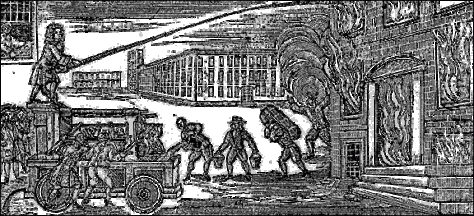In 1802, the Town of Hingham authorized the construction of firehouses at Little Plain (Hingham Centre) and Broad Bridge (Hingham Square), although the responsibility to acquire the fire engines themselves rested with private citizens—the proprietors of Engine Companies No. 1 and 2. The “hand tub” engines that they commissioned and paid for were large wooden tubs placed on carts for mobility and filled by hand from the nearest water source. Once the bucket was full, firemen pushed long wooden bars (“brakes”) up and down, setting in motion a piston in the tub that pumped the water out through a hose and nozzle.

Francis H. Lincoln wrote in the 1893 History of the Town of Hingham:
If one were to imagine a fire in those days he would see a company of perhaps fifteen men at work upon the brakes and attending to the hose and pipe, while a line of men and women stretched away to the nearest water, which they passed from hand to hand in buckets, emptying it into the tub, passing the empty buckets back by another line to be filled again.
 This wooden tub is from the Little Plain Engine, No. 1, nicknamed the “Precedent” because it was the first of what would ultimately be four such engines to be completed. It was manufactured by local craftsmen: Peter Sprague made the tub from cedar furnished by Thomas Fearing. The ironwork was by the local firm of Stephenson and Thomas.
This wooden tub is from the Little Plain Engine, No. 1, nicknamed the “Precedent” because it was the first of what would ultimately be four such engines to be completed. It was manufactured by local craftsmen: Peter Sprague made the tub from cedar furnished by Thomas Fearing. The ironwork was by the local firm of Stephenson and Thomas.
In 1830, the Town’s first suction apparatus, the “Hingham,” was acquired and “hand tubs” or “bucket tubs” such as the Precedent became obsolete.
The tub was reassembled and stabilized in recent years by Dick Kenney of the Bare Cove Fire Museum. It is currently on display at the Hingham Heritage Museum, on loan from the Bare Cove Fire Museum, 45 Bare Cove Park Drive, Hingham, MA 02043.